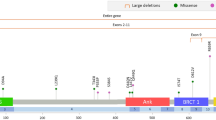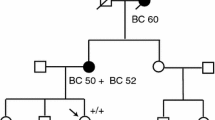Abstract
MERIT40 is a recently identified BRCA1 and RAP80 interacting protein that is essential for protein–protein interactions of a BRCA1 complex also containing Abraxas, BRCC36 and BRCC45. It is a mediator of checkpoint functions and DNA damage signaling through a (de)ubiquitination cascade. Based on its interaction with BRCA1 and its role in genome integrity maintenance, MERIT40 is a novel candidate gene for being involved in hereditary susceptibility to breast cancer. Here, we report to our knowledge the first comprehensive mutation screening of this gene in affected cases of breast cancer families. Only a number of sequence variants were found, four of which are novel. None of the observed variants appeared to be disease related, suggesting that germline mutations in MERIT40 are rare or absent in familial breast cancer patients.

Similar content being viewed by others
References
Anglian Breast Cancer Study Group (2000) Prevalence and penetrance of BRCA1 and BRCA2 mutations in a population-based series of breast cancer cases. Br J Cancer 83:1301–1308
Easton DF, Pooley KA, Dunning AM et al (2007) Genome-wide association study identifies novel breast cancer susceptibility loci. Nature 447:1087–1093
Stratton MR, Rahman N (2008) The emerging landscape of breast cancer susceptibility. Nat Genet 40:17–22
Rahman N, Stratton MR (1998) The genetics of breast cancer susceptibility. Annu Rev Genet 32:95–121
Wooster R, Weber BL (2003) Breast and ovarian cancer. N Engl J Med 348:2339–2347
Erkko H, Xia B, Nikkilä J et al (2007) A recurrent mutation in PALB2 in Finnish cancer families. Nature 446:316–319
Seal S, Thompson D, Renwick A et al (2006) Truncating mutations in the Fanconi anemia J gene BRIP1 are low-penetrance breast cancer susceptibility alleles. Nat Genet 38:1239–1241
Ghimenti C, Sensi E, Presciuttini S et al (2002) Germline mutations of the BRCA1-associated ring domain (BARD1) gene in breast and breast/ovarian families negative for BRCA1 and BRCA2 alterations. Genes Chromosom Cancer 33:235–242
Karppinen SM, Heikkinen K, Rapakko K et al (2004) Mutation screening of the BARD1 gene: evidence for involvement of the Cys557Ser allele in hereditary susceptibility to breast cancer. J Med Genet 41:e114
Shao G, Patterson-Fortin J, Messick TE et al (2009) MERIT40 controls BRCA1-Rap80 complex integrity and recruitment to DNA double-strand breaks. Genes Dev 23:740–754
Feng L, Huang J, Chen J (2009) MERIT40 facilitates BRCA1 localization and DNA damage repair. Genes Dev 23:719–728
Wang B, Hurov K, Hofmann K et al (2009) NBA1, a new player in the Brca1 A complex, is required for DNA damage resistance and checkpoint control. Genes Dev 23:729–739
Kim H, Chen J, Yu X (2007) Ubiquitin-binding protein RAP80 mediates BRCA1-dependent DNA damage response. Science 316:1202–1205
Sobhian B, Shao G, Lilli DR et al (2007) RAP80 targets BRCA1 to specific ubiquitin structures at DNA damage sites. Science 316:1198–1202
Wang B, Matsuoka S, Ballif BA et al (2007) Abraxas and RAP80 form a BRCA1 protein complex required for the DNA damage response. Science 316:1194–1198
Ewing RM, Chu P, Elisma F et al (2007) Large-scale mapping of human protein–protein interactions by mass spectrometry. Mol Syst Biol 3:89
Rual JF, Venkatesan K, Hao T et al (2005) Towards a proteome-scale map of the human protein–protein interaction network. Nature 437:1173–1178
Kim H, Huang J, Chen J (2007) CCDC98 is a BRCA1-BRCT domain-binding protein involved in the DNA damage response. Nat Struct Mol Biol 14:710–715
Liu Z, Wu J, Yu X (2007) CCDC98 targets BRCA1 to DNA damage sites. Nat Struct Mol Biol 14:716–720
Chen X, Arciero CA, Wang C et al (2006) BRCC36 is essential for ionizing radiation-induced BRCA1 phosphorylation and nuclear foci formation. Cancer Res 66:5039–5046
Dong Y, Hakimi MA, Chen X et al (2003) Regulation of BRCC, a holoenzyme complex containing BRCA1 and BRCA2, by a signalosome-like subunit and its role in DNA repair. Mol Cell 12:1087–1099
Wang B, Elledge SJ (2007) Ubc13/Rnf8 ubiquitin ligases control foci formation of the Rap80/Abraxas/Brca1/Brcc36 complex in response to DNA damage. Proc Natl Acad Sci USA 104:20759–20763
Shao G, Lilli DR, Patterson-Fortin J et al (2009) The Rap80-BRCC36 de-ubiquitinating enzyme complex antagonizes RNF8-Ubc13-dependent ubiquitination events at DNA double strand breaks. Proc Natl Acad Sci USA 106:3166–3171
Stewart GS, Panier S, Townsend K et al (2009) The RIDDLE syndrome protein mediates a ubiquitin-dependent signaling cascade at sites of DNA damage. Cell 136:420–434
Greenberg RA (2008) Recognition of DNA double strand breaks by the BRCA1 tumor suppressor network. Chromosoma 117:305–317
Nikkilä J, Coleman KA, Morrissey D et al (2009) Familial breast cancer screening reveals an alteration in the RAP80 UIM domain that impairs DNA damage response function. Oncogene 28:1843–1852
Acknowledgments
We wish to thank Dr. Aki Mustonen, Dr. Jaakko Ignatius and nurses Kari Mononen and Outi Kajula for their help in sample and data collection and also in patient contacts, Helmi Konola and Meeri Elina Otsukka for technical assistance and Hannele Erkko for critical reading of the manuscript. We thank all the patients and their family members for volunteering to participate in these studies, as well as the Finnish Red Cross Blood Service for help with collection of population control blood samples. This study was financially supported by the Sigrid Jusélius Foundation, the Academy of Finland, CIMO, the Orion-Farmos Research Foundation, the Northern Ostrobothnia Fund of the Finnish Cultural Foundation, the University of Oulu, and the Oulu University Hospital.
Author information
Authors and Affiliations
Corresponding author
Electronic supplementary material
Below is the link to the electronic supplementary material.
Rights and permissions
About this article
Cite this article
Solyom, S., Patterson-Fortin, J., Pylkäs, K. et al. Mutation screening of the MERIT40 gene encoding a novel BRCA1 and RAP80 interacting protein in breast cancer families. Breast Cancer Res Treat 120, 165–168 (2010). https://doi.org/10.1007/s10549-009-0453-7
Received:
Accepted:
Published:
Issue Date:
DOI: https://doi.org/10.1007/s10549-009-0453-7




